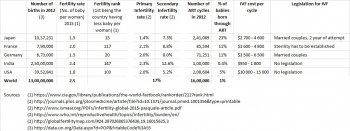10/09/2017
Fertility, infertility, assisted reproduction and medical tourism in India
Recently an Indian la dy came to my office to discuss about about infertility and breastfeeding. Curious, I asked almost immediately what is India’s rank in terms of infertility on a global scale. I had been curious about that for a while actually, as I see more and more ‘infertility centers’ popping up everywhere in the last few years.
dy came to my office to discuss about about infertility and breastfeeding. Curious, I asked almost immediately what is India’s rank in terms of infertility on a global scale. I had been curious about that for a while actually, as I see more and more ‘infertility centers’ popping up everywhere in the last few years.
Her answer surprised me: according to her, the countries most affected by infertility are Japan and Germany. Who would have thought? I wouldn’t, neither did I believe it…
So I dug a little and soon discovered that it is actually almost impossible to find a clear answer to my question; for one thing the infertility criteria vary from one country to another, making it almost impossible to make any world ranking and also because censuses can only be far from comprehensive – all the people who do not reproduce don’t necessarily get checked for infertility.
What could she mean then? Did she mistake infertility rate (or number of people who can not conceive a child) and fertility rate (or number of births per woman)?
India is a country where women justify their presence in the world only when they become a mother – that is still strongly the case and that’s why we see very old ladies becoming first time mothers (source). Taking this into account, I wouldn’t be too surprised if, for her, when a woman has no child it is not a question of choice but just because she can’t.
But even then, Japan and Germany are not on top of the least fertile countries (see table below).
Where Japan ranks first, however, is in the number of births using ART (Artificial Reproductive Technology). Perhaps she mistook infertility and assisted reproduction?
Both are not the same. One can for instance imagine that in some countries (like Japan) parents rely more on medical assistance than in other countries, not only because they are medically infertile, but also because they do not have sex (no time, no desire (source)), or because ART is affordable or covered by insurances, or because of some other reasons. I make this assumption because if Japanese champion the number of assisted procreations, their infertility rates appear to be even lower than elsewhere (see table below). In short, there is no evidence that the Japanese face more difficulties to conceive, but everything indicates that the use of a medical assistance has become quite common.
But let us get back to our Indian business. The numbers that I’ve gathered suggest that 45% of couples suffer from infertility in India (source) but less than 1% of the affected couples seek medical advice (source).
And yet I see boards at almost every street corner, signaling a clinic specializing in the treatment of infertility. And almost every gynecologist now claims to be an IVF specialists.
In short, it is almost impossible to tell if there are more procreations medically assisted in India because 1. There is an increasing number of infertile couples in India – a hypothesis linked to urbanization rates, obesity trends, number of women with professional careers rising up, hypothesis put forward by the media; 2 Indians are increasingly going past the social stigma associated with the state of infertility and seek more official medical help (because I’m sure there are many cases not reported, we know already that 60% of ‘physicians’ in India have no medicine degree (source)); 3. Doctors have found a honey pot and invest on it – the less ethical ones would not hesitate too much before inseminating or implanting an embryo in Indian couples with non-existent sex life rather than counselling them, other ones focusing on the international patient base who more and more comes to India to make a baby because it is three times cheaper here than in the United States (see table below); Or probably it is a mix of all these factors.
A small digression to conclude: India seems to be the hub of parenthood. Apart from the medical tourism of fertilization, there is the adoption business or even the business of surrogacy. India got famous about this abroad in 2007, when an Oprah’s show staged a Western couple going to India and its plethora of surrogate mothers. Because it took too important proportions – foreigners (and Indians) doing their shopping and surrogates being paid peanuts (since agents and doctors keep the jackpot for themselves), the Government tried to put an end to this in 2016. Which means they prohibited surrogacy purely and simply*. It’s easier to ban than to put controls in place. Although it encourages the development of the black market of surrogacy and it is the surrogate mothers who end up suffering the most.
It’s kind of what happened with adoption. Until the 1970s, India had more and more orphans and Indians were reluctant to adopt – because of the social stigma, and the apprehension of bringing someone in the family that they know nothing about, with caste requirements and all (source). But foreigners were keen on adopting. Which obviously led to some derivatives, such as theft and trafficking of kids by some ill-intentioned Indians. Following scandals in the 1990s, India toughened the laws and made every adoption difficult, even for Indians. However it seems that the Government has been making the rules related to adoption easier since 2015.
* After the new law (source) only an Indian couple having tried without success to have a baby for more than five years can have recourse to a surrogate mother, who must be from the family, and they will only pay for the medical expenses, no incentive.
Sources : http://www.prsindia.org/billtrack/the-surrogacy-regulatio...? ; https://www.cia.gov/library/publications/the-world-factbo... ; https://www.palashivf.com/2017/02/21/ivf-treatment-market... ; http://www.ey.com/Publication/vwLUAssets/EY-call-for-acti... ; http://www.dailyo.in/lifestyle/infertility-on-the-rise-in... ; http://www.who.int/reproductivehealth/topics/infertility/... ; http://journals.plos.org/plosmedicine/article?id=10.1371/... ; http://www.ijsr.net/archive/v4i7/SUB156201.pdf ; http://www.aurumequity.com/ivf-india/ ; https://www.researchgate.net/publication/236005514_Adopti...
08:00 Posted in Incredible India! | Permalink | Comments (0) | Tags: india, fertility, infertility, ivf, art, cost, comparison | ![]() Facebook | |
Facebook | |
03/02/2015
Baby Samourai made-in-India – 7. After the pool
Eventually they took me out of the water for good. And then, I was swimming (note the water metaphor, it's beautiful isn’t) in complete surrealism.
Imagine. I've always been the first one to say, as more than 80% of the French (2), that if I give ever birth, I will get the epidural. No question about it! With my argument: when you go to the dentist, you get an anesthesia. Well here it’s the same.
And here I was, drowning in pain, and saying nothing. Nothing at all. Not a word. I suffered in SILENCE. Just a voice in my head screaming "but just give me a fucking epidural already!"). A Samourai in all its glory!
And there, out of nowhere an anesthetist materialized, almost sorry to be there: everyone seemed to over-convinced that I wanted a natural birth (probably because I had opted for the water birth) and therefore was against painkillers. So I had to listen to the speech of my doctor who explained to me that I had no reason to be ashamed of reducing pain, that I had already gone through a lot, and that she herself had given birth to twins by caesarean. In total surrealism I was swimming, I tell you!
I refused to sniff gas and but accepted a spinal (no time for the epidural). Immediate relief!
In short, I ended up giving birth... Lying on a table, legs spread, with my favorite Indian, three gynecs, two pediatricians, an anesthetist, a midwife, and six nurses in the room. And I couldn’t care less! It actually even made me laugh thinking back of the 'intimate' childbirth I had planned!
And Baby Samourai was there! On my chest! Peeing on me! That’s how we realized it was a boy: doctors had forgotten to check...
In India, sex determination of the fetus is prohibited, since Indians took advantage of this technology to abort girls – which are expensive, with the dowry. India has a deficit of girls, and in some States it has started to cause serious problems, having to import brides and all (see these posts for more on the topic).
And the final word: baby Samourai hates baths, which should not surprise anyone... ;-)
(2) The French are apparently more sensitive than the British since only 30% of the latter opt for anesthesia (Sources: http://www.liberation.fr/vous/2011/10/18/70-d-accouchements-avec-peridurale_768628;) http://www.babycentre.co.UK/a542571/epidural)
(The End)
08:00 Posted in Expatriation (in India and in other countries), Incredible India!, Little Samourai, My stories in India | Permalink | Comments (0) | Tags: india, birth, water birth, pregnancy, baby, infant, newborn, delivery, midwife, swaddling, swaddle, diaper, breastfeeding, hospital, fertility, contraception, sterilization | ![]() Facebook | |
Facebook | |
02/28/2015
Baby Samourai made-in-India – 6. In the pool
 At 6 o'clock we set foot (and wheelchair) for the delivery room to attend the filling of the pool – apparently the sound of running water itself encourages the cervix to open up. And all of a sudden I was very far from the idea I had of water birth. Yes, curiously, despite the awful video, I still had romantic images of the thing.
At 6 o'clock we set foot (and wheelchair) for the delivery room to attend the filling of the pool – apparently the sound of running water itself encourages the cervix to open up. And all of a sudden I was very far from the idea I had of water birth. Yes, curiously, despite the awful video, I still had romantic images of the thing.
First the image of a naiad frolicking in a hot water spring, her long hair covering her bare breast (reserved, the naiad), birds joyfully chirping in the surrounding trees. And splash, a small cry, and her baby is there, swimming around her. A natural childbirth, I thought, going back to the (hot) source. Looking back, I had overlooked that most births happen night – the outing in the jungle is immediately less romantic – and that I should probably go back to prehistory to find an ancestor who had tried this method, so maybe not so ‘natural’ after all.
Another image I had, more 'modern', was of a five star bathtub, with bubbles, bath salts, scented candles, music and a glass of white wine. This vision almost made me eager to give birth!
But there, as everyone was busy setting up the whole thing and the horror of the situation was striking me in the face – I was going to have to go into this inflatable pool and suffer – I didn’t dare shout out to misunderstanding ("STOOOOP! Stop everything! I don’t want this! I and to go and lay on the table, I want the epidural!”). No, instead, I took off the horrible hospital gown and stepped into the pool. This is when the midwife offered to go pick up my sport bra. I was already in so much pain that I didn't care being in the pool with only my bra, nevermind, it was too much effort to change. She also offered to plug my MP3 but suddenly the slightest sound was painful to hear (so much for all the relaxation tracks I had downloaded!).
Once in the water, the Gynec asked me if I the pain had reduced. Apparently she was expecting a positive answer and eager to please her, I nodded. “Yes it’s always the same!”, she was happy. In fact I was in so much pain that I could only sit in a corner, immobile, hoping that it would go away if I didn’t move a muscle. After an hour, to please the midwife, I tried another position. And spent the next hour immobile in another corner, but squatting.
I must have stayed 3 hours in the water. Small breaks I was taken out to pee in a portable toilet (despite the encouragement of the medical team, I could not bring myself to piss in the pool), and other fun stuff. Finally my Gynec surrendered: there was nothing to do, my cervix refused to go faster than the music and hot water was not accelerating its opening.
(To be continued...)
08:00 Posted in Expatriation (in India and in other countries), Incredible India!, Little Samourai, My stories in India | Permalink | Comments (0) | Tags: india, birth, water birth, pregnancy, baby, infant, newborn, delivery, midwife, swaddling, swaddle, diaper, breastfeeding, hospital, fertility, contraception, sterilization | ![]() Facebook | |
Facebook | |















